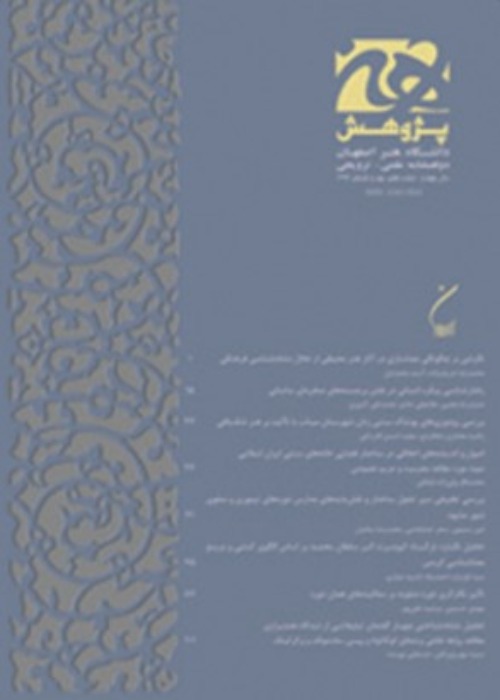Typology of the inscriptions Chaharbagh Mosque-school of Isfahan with an emphasis on structural features
Author(s):
Article Type:
Research/Original Article (ترویجی)
Abstract:
Chaharbagh Mosque-school of Isfahan, being one of the most important monuments of Shah Soltan Hossein in the Safavid era, is of chief importance regarding its structure and decorations. The inscriptions are the most prominent features of the art treasure of the Safavid era, that are the best in terms of quality and variety compared to other monuments of the same period. The present study attempts to classify and typology the external structure and themes of the inscriptions of the mentioned building with a multidimensional point of view, and also recognizing the Chaharbagh Mosque-school briefly. The mentioned procedures lead to two questions: 1- According to the considered criterions, what are the different types of inscriptions of the monument? 2- What are their prominent features? The method of this study that is carried out by a typology approach is analytical-descriptive. Data is collected through field and library methods. The data is analyzed qualitatively. The results of the examinations indicate that the most distinctive and important features of the inscriptions of Chaharbagh Mosque-school are the type of materials, the executing techniques, type of lines, the combination of the letters, and also the famous calligraphic artists, which are the base of classifying and typology of the current paper. Accordingly, the inscriptions which are made by using different techniques of tile work, etching, gold work, inlaid, wood work, engraving on stones and even Zilu weaving, and include Suls, Kufi (Bana'i and Muaiqly) and Nastaliq calligraphy, is a collection of the artworks of famous calligraphic artists such as Mohammad Saleh Esfahani, Ali Naghi Emami and Rahim Jazayeri that their works are not seen in many monuments. The most important themes used in these inscriptions are Quranic themes, hadiths and narratives, eulogy of the Prophet, Hazrat Ali, and other Imams, and also some information about the supporter, executors, and the benefactor of the building which are expressed in the form of Arabic texts and Persian poetic and prose.
Keywords:
Language:
Persian
Published:
Journal of Pazhuhesh-e Honar, Volume:8 Issue: 15, 2018
Pages:
71 to 85
magiran.com/p1904764
دانلود و مطالعه متن این مقاله با یکی از روشهای زیر امکان پذیر است:
اشتراک شخصی
با عضویت و پرداخت آنلاین حق اشتراک یکساله به مبلغ 1,390,000ريال میتوانید 70 عنوان مطلب دانلود کنید!
اشتراک سازمانی
به کتابخانه دانشگاه یا محل کار خود پیشنهاد کنید تا اشتراک سازمانی این پایگاه را برای دسترسی نامحدود همه کاربران به متن مطالب تهیه نمایند!
توجه!
- حق عضویت دریافتی صرف حمایت از نشریات عضو و نگهداری، تکمیل و توسعه مگیران میشود.
- پرداخت حق اشتراک و دانلود مقالات اجازه بازنشر آن در سایر رسانههای چاپی و دیجیتال را به کاربر نمیدهد.
In order to view content subscription is required
Personal subscription
Subscribe magiran.com for 70 € euros via PayPal and download 70 articles during a year.
Organization subscription
Please contact us to subscribe your university or library for unlimited access!



